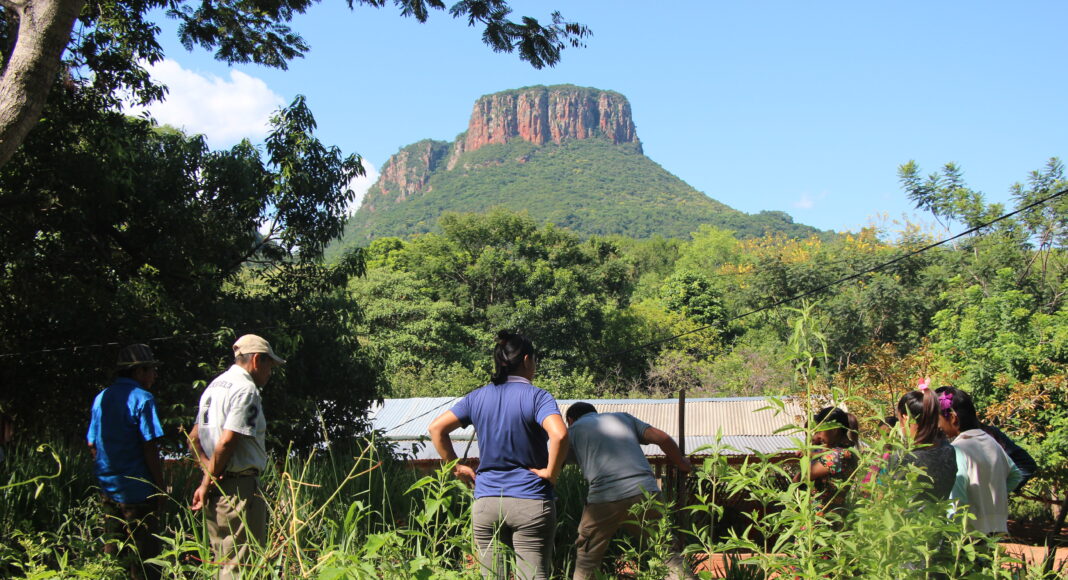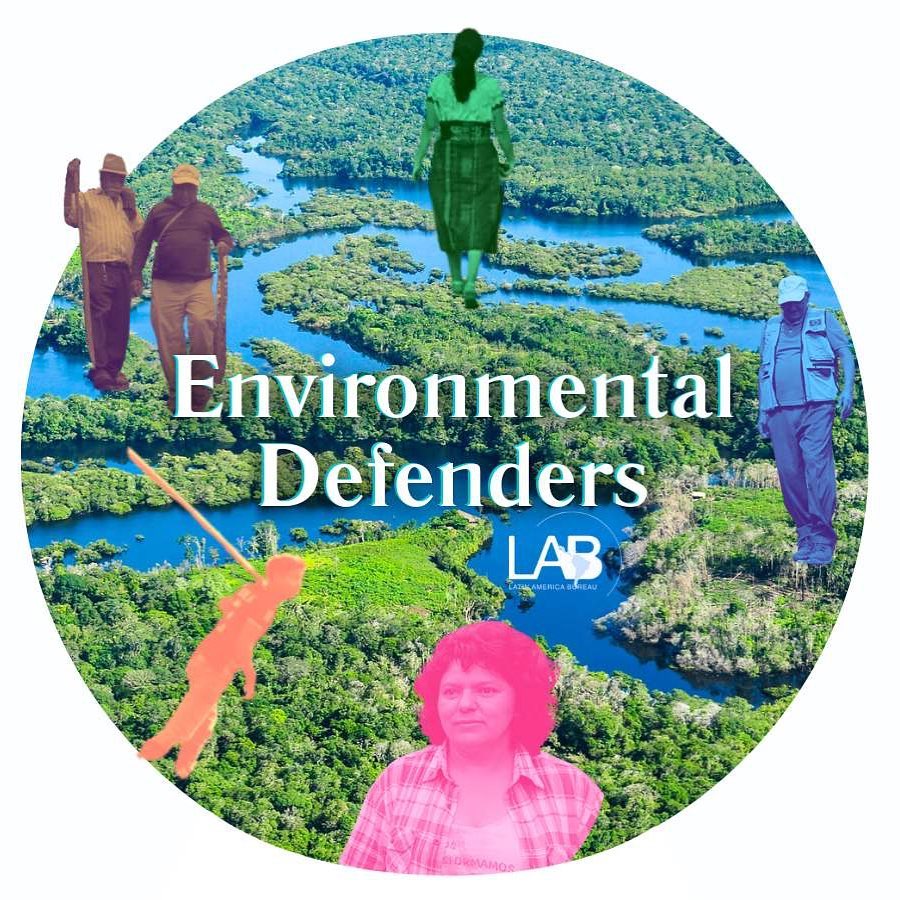The Paĩ Tavyterã Indigenous people, whose ancestral territory is in the northeast of Paraguay, are taking concrete actions to combat the fierce impacts of climate change felt in their communities. They are adapting their agricultural practices to be more resilient and are learning to combat the wildfires that have devastated the region over recent years, employing traditional knowledge to recover forests lost to the fires and to avoid the incursion of invasive grass species used by neighbouring cattle ranchers, which are highly disruptive to native ecosystems.
The final wafts of thick early-morning mist can be seen evaporating off the surrounding expanses of grassland as the 4×4 driven by Silvino Mendoza picks its way along the dirt road.
With the rising sun announcing yet another boiling day of almost 40 degrees, he reflects in Guarani: ‘The mist used to stay around until at least midday. That was before’.
Mendoza, president of the Paĩ Retã Joaju Association of the Paĩ Tavyterã Indigenous People and leader of the community of Cerro Akangue, explains that this is just one of a series of immense environmental changes he has witnessed over his lifetime here in the department of Amambay, northeast Paraguay.
Just 20 years ago, dense forest covered this area in the heart of the ancestral territories of the Paĩ Tavyterã, which extend across the nearby border into southern Brazil. Now, the subtropical trees, whose shade and moisture gave those extra hours of daily life to the mist, have been cleared to make way for sprawling cattle ranches.
These local transformations combine with the ever-intensifying impacts of global climate change to create enormous challenges for the Indigenous communities scattered across the Amambay landscape. However, in the face of increased drought, flooding, heat waves, wildfires, and the incursion of invasive species, the Paĩ Tavyterã are pushing to implement concrete actions to resist and adapt in order to protect their territories, culture, and livelihoods.
Planting resilience
Mendoza’s 4×4 plunges into what is—apart from the soaring green hills that punctuate the flat terrain—the only sizeable stretch of forest left in the area. The vehicle soon stops in a leafy, shaded clearing, where two oypysy—temples coated in straw from top to bottom—stand alongside a meeting area. This is the centre of Yvy Pyte, a community of around 500 families and one of the final remaining tekoha guasu—the great ancestral territories—of the Paĩ Tavyterã. Around 30 men, women and children steadily arrive, sitting down on the chairs and long benches.
Through the surrounding canopy, the nearby conical hill of Jasuka Venda can be seen. This densely forested mount is the most sacred site of the Paĩ Tavyterã, where creator god Ñane Ramõi Jusu Papa is said to have brought himself and the world into being.
Tragically, the great wealth held in Paĩ Tavyterã land and natural resources, vital for their own culture and subsistence, has not gone unnoticed by outsiders. Yvy Pyte is currently facing a fierce invasion by armed groups that look to extract the precious native woods and enclose the land for ranching. As such, community members face the double challenge of a daily battle to defend their land from these human invaders—with minimal support from accountable state institutions—while also working to adapt to the impacts of the changing climate.
Indeed, climate change is ever-more palpable in Paraguay, the country most vulnerable to the phenomenon in South America, according to the CAF development bank of Latin America and the Caribbean. A 2019 official report from the Paraguayan Environment Ministry states that cycles of drought and flooding have intensified and that the frequency of heat waves tripled from 1980 to 2019. In the country’s northeast, Amambay experienced serious flooding in 2023, and now there is a dangerous lack of rain.
‘We’re seeing strong drought in Yvy Pyte’, says Nora Rosatti, an attentive and charismatic community leader. ‘The ground dries up and we lose our crops: they don’t grow, they don’t sprout. We’re left with no water.’
Yvy Pyte is one of several Paĩ Tavyterã communities now looking to alleviate this severe threat to their vital subsistence agriculture through partnership with local NGO Áry Ojeasojavo. Pablo González Parini, a specialist in agroecology from the organization, emerges from Mendoza’s 4×4. At the request of communities, he has been running a series of workshops on agroecological techniques that can complement ancestral practices to increase climate resilience.

Today, he shows the gathered community members how to use a simple A-shaped frame, quickly constructed from three tree branches, to plant crops along contour lines padded out with leaf mulch.
‘It’s an age-old technique that is used by other Indigenous Peoples’, he says. ‘It reduces soil erosion in heavy rain and increases water retention in times of drought’.
Numerous men and women test out the A-frame with patient enthusiasm, tracing out contour lines across the shaded meeting circle.
‘My cassava crop has been affected by the drought, it hardly has any roots and isn’t very soft’, says Catalino Fernández, another leader. ‘I’m going to weed and plant along contour lines so that when the rain comes, the water isn’t lost and my plants will grow better and be greener’.
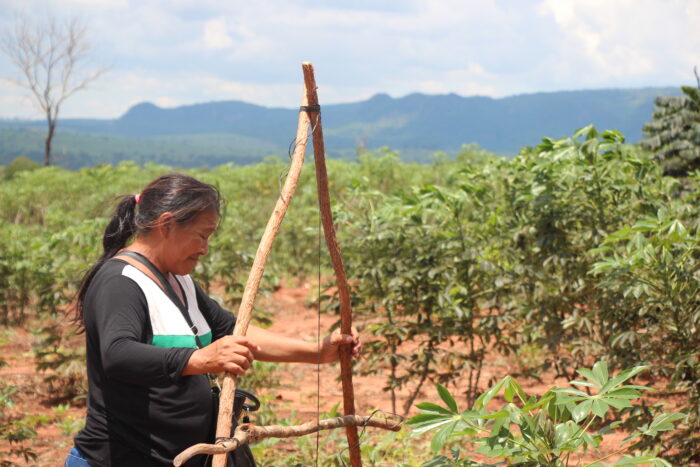
Pushing for state action
Paĩ Tavyterã resistance to climate change is not restricted to internal actions on their land. Communities are also working to push the state institutions that are responsible for guaranteeing their rights to effectively fulfill their role.
This is no small feat, given that the 20 Indigenous Peoples that live in present-day Paraguay are by far society’s most marginalized groups, and have faced strong historical discrimination and neglect from local and national authorities. They have poverty rates much higher than those of the general population and face enormous obstacles in accessing basic rights and services.
Despite this difficult context, Paĩ Tavyterã associations manage to make themselves heard. For example, in 2022, following extended advocacy from leaders and their NGO allies, key figures from a number of government bodies, such as the Ministry for the Environment and Sustainable Development’s (MADES) Directorate for Climate Change and the Paraguayan Indigenous Institute (INDI), carried out a voluntary visit to Amambay to discuss environmental challenges facing the Paĩ Tavyterã.
During a phone call, Ulises Lovera, civil servant at MADES and the ministry’s Director for Climate Change at the time of the 2022 visit, spoke of the enormous importance and value of on-the-ground contact between institutions and communities. However, he expressed disappointment that the trip had not yet produced specific actions from the ministry to tackle the pressing environmental issues.
‘Listening, learning, feeling what is happening in the communities is important. But that knowledge of reality must lead to solutions to the problems. That is the step that has yet to be taken – it is important for it to be taken’, he said.
Lovera emphasized that within Paraguay’s situation of high vulnerability to climate change—largely due to its nature as a landlocked nation—Indigenous Peoples are among the groups in the situation of greatest vulnerability. He added that, although some work has been carried out with Indigenous organizations, a thorough government study to listen to Indigenous Peoples’ vulnerabilities, needs, and interests in the face of climate change is imperative.
In the absence of significant state support, Indigenous associations and their NGO allies continue with the testing task of climate adaptation.
Christian Kent, a coordinator of Áry Ojeasojavo NGO, said that large efforts are being made— for example, through a current project funded by the British Embassy in Paraguay— but tight finances often place a limit on the reach of activities.
‘In terms of the current environmental crisis, Indigenous Peoples have effectively no responsibility and they are the ones that are most suffering the consequences’, said Kent. ‘The government must recognise this and work with them to develop solutions’.
Unfortunately, many state institutions have continually shown themselves to be much more concerned with supporting sectors such as the powerful cattle and soyabean industries. These are the very industries that have driven the ongoing environmental degradation of the country over recent decades, and whose spokespeople have frequently questioned the existence of climate change.
Wildfires in Paĩ Tavyterã Territory
Back in Yvy Pyte, in the kokue, the crop field, of leaders Dionisia Ferreira and Laurio Rossati, the A-frame is put into practice. Among rows of native varieties of cassava—such as mandi’o say’ju (yellow cassava), unseen in the capital Asunción—community members draw out contour lines.
At the end of the workshop, with the sacred hill of Jasuka Venda as a backdrop, Ferreira speaks of another environmental issue that is taking a large toll on communities: a rise in wildfires.
The increasingly dry conditions create ideal circumstances for the propagation of fires. In 2019, across Paraguay, 320,000 hectares of forest were destroyed by wildfires and 150,000 hectares were burnt in 2020. Paĩ Tavyterã families have lost homes and crops, and Jasuka Venda was badly affected in both 2019 and 2021, putting its forests and cultural and archaeological wealth at severe risk.
‘The fire destroys all of nature. It burns the forest, the animals, the honey. It burns the medicines that we get from nature, it burns the ysypo [vines] and karaguata [vase plant]’, says Ferreira with evident sadness in her voice. ‘Climate change is changing everything. The drought is too strong’.
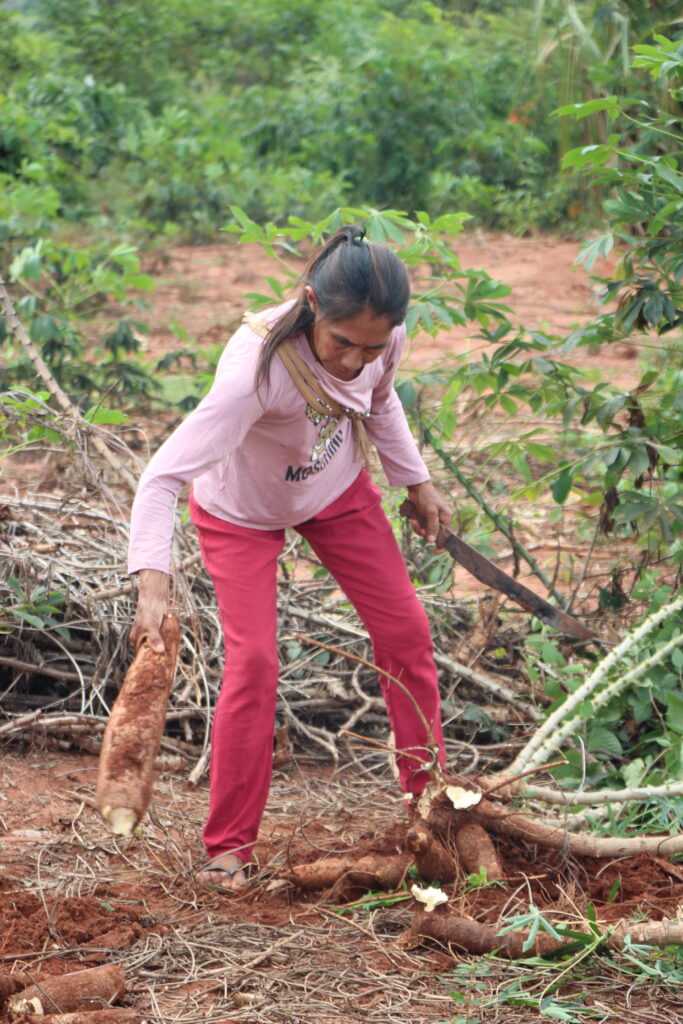
Faced with these threats, she is adamant that communities must continue to pressure institutions to fulfil their responsibility to protect Paĩ Tavyterã land, livelihoods, and culture.
‘It is essential for us to talk about this issue here and everywhere to stop the fires: they are causing too much damage to us. If we can’t stop them, the ground is going to get even drier. Only through dialogue can we stop the burning’, Ferreira says.
Fire and grass
The wildfires are also spoken about the following day, around 50 km from Yvy Pyte, as work with A-frames and contour lines continues in Ita Guasu. This Paĩ Tavyterã community sits under a towering, craggy hill that gives it its Guarani name, literally ‘Big Rock’.
The workshop is taking place at the home of Rosalba Gómez, a young leader who is studying law in the nearby regional capital of Pedro Juan Caballero. She explains that she wants to specialize in civil law so that she can support communities such as Yvy Pyte in their struggles to protect their land from invasion.
Gómez says that for a very long time her community has been taking steps to increase their capacity to manage and respond to wildfires, following her grandfather’s participation in firefighting workshops with Indigenous communities in Bolivia. By organizing fire brigades, in which the whole community participates, they have not had a major incident for approximately 30 years, despite the growing intensity of the fires.
‘The fires have become a lot more extreme in the last few years. But in Ita Guasu we have been working hard to control them’, says Gomez.
They were also one of several Paĩ Tavyterã communities, including Yvy Pyte, that requested and participated in another recent workshop on the fires, coordinating with the National Emergency Secretariat (SEN), the National Commission for the Defence of Natural Resources (CONADERNA) and rangers from nearby Cerro Corá national park.
‘The workshop gave us more information on how to put out fires, how to make tools. It was very useful, and the information has been transmitted to other people in the community’, says Gómez.
In spite of these enormous efforts, Paĩ Tavyterã associations have stated that much more official support and mutual aid is needed to protect their territories, including urgent financial support to purchase further tools required to fight fires safely and effectively.
Gómez also mentions another issue left by the flames. Species of non-native grasses, planted in the fields of the surrounding ranches to feed cattle, quickly spread and grow in areas that have been stripped by wildfires. The high-growing grass then becomes an incredibly flammable fuel for future fires.
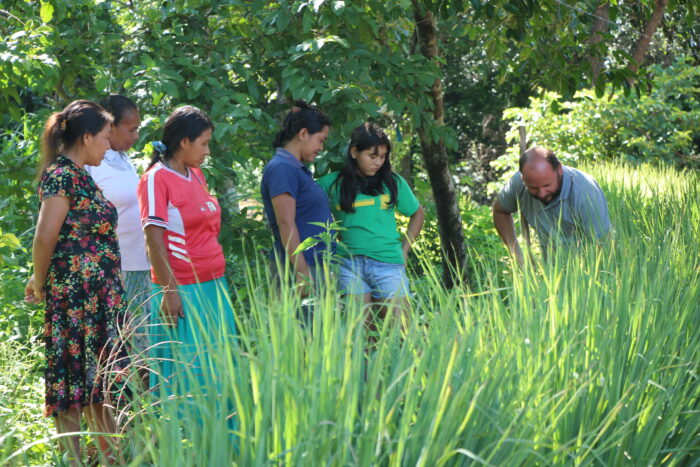
‘The grass is terrible because, wherever its seeds land, it sprouts and doesn’t stop, it keeps growing and growing and growing. It kills the forest’, says Gómez. ‘Wherever it appears, we can’t plant anything because the soil doesn’t have any nutrients anymore. It ruins and dries the soil’.
Though communities have repeatedly petitioned state institutions to take actions on the issue, no response has been forthcoming.
In collaboration with González Parini, the communities are beginning to implement their own methods to fight back against the grass, such as making “bombs” of clay and the seeds of certain native plant species that can overcome the grass and catalyze the regeneration of the forests.
‘[González Parini] told us to plant ysypo next to the grass. Because the ysypo fights against it and holds it back’, says Gómez.

Steps towards resilience
Through these and other methods, the Paĩ Tavyterã are displaying their need and capacity to adapt to the environmental changes for which they have little responsibility. This is evident in Gómez’s crop field, just metres from her family’s home, where she has already sown plants along contour lines after participating in a previous agroecological workshop.
Much to the delight of González Parini, Gómez says that planting the vibrant green lemon verbena has improved the quality of the soil. Soil erosion, linked to the almost total deforestation of the area around Ita Guasu, is a major issue for the community. Gómez says that contour planting has reduced the thick mounds of dust that tend to accumulate against the walls of her house.
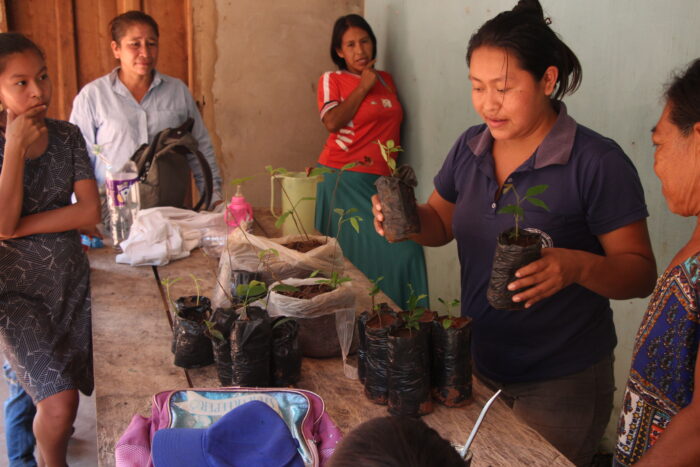
‘The ground was soil without nutrients. It was dry. This technique is so important for us women too, because we love to plant things’, she says.
At the end of the workshop, Gómez appears with a number of varied seedlings in plastic grow bags, inviting other participants to take them home with them. She explains:
‘This was an idea that came about through meetings between us women where we spoke about the many native plants that have disappeared. When I was a child, I used to eat yvaguasu and yvapurũ [both types of fruit] from the forest. Now there aren’t any left in Ita Guasu’, she says. ‘So, we searched out the seeds and planted them so we can give them to other women’.
Gómez and the other participants are clear that another priority is to transmit their knowledge and experience to the younger generations. As such, they agree that the next agricultural workshop should be held in the grounds of the community’s school, so that the children can continue the work of protecting the rich environmental heritage of the Paĩ Tavyterã amid the increasing climatic uncertainty that they have so little responsibility for.
‘There are many children that have never seen these plants and that don’t know about them’, says Gómez. ‘Like so much of our way of life, it’s vital for the plants to be known again so that they don’t disappear’.

